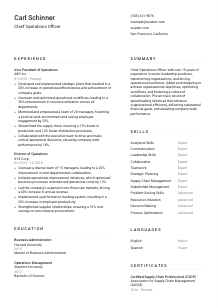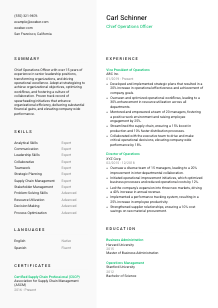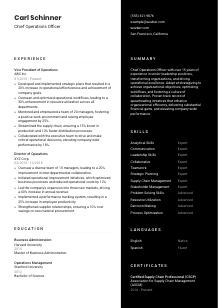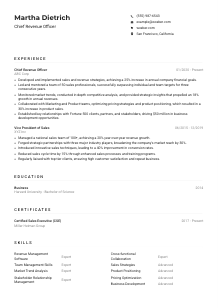Chief Operations Officer Resume Example
Running operations, but your resume feels out of order? Delve into this Chief Operations Officer resume example, streamlined with Wozber free resume builder. Discover how you can succinctly position your strategic leadership to match job directives, propelling your career to the executive frontlines where everything falls perfectly into place!
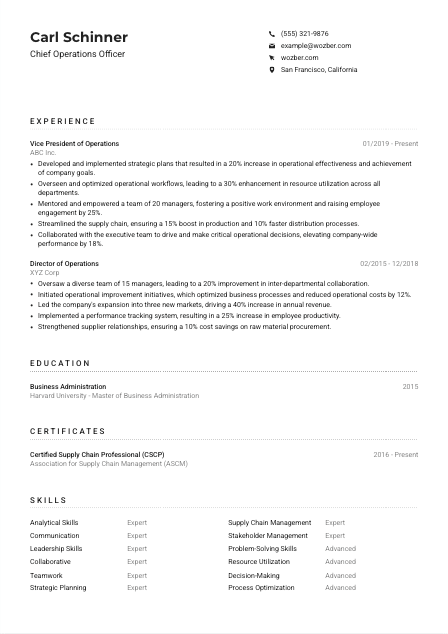
How to write a Chief Operations Officer Resume?
Embarking on the journey to secure a Chief Operations Officer position means preparing to present yourself not just as a candidate, but as the solution to an organization's operational challenges. Your resume is your personal marketing blueprint, and with the right strategy, it can open doors to executive opportunities. With Wozber's free resume builder, you're equipped to craft a resume that is not only compelling and comprehensive but also optimized for Applicant Tracking Systems (ATS). Let's dive into creating a resume that showcases your expertise, aligns with job requirements, and positions you as the ideal Chief Operations Officer.
Personal Details
Beginning with the Personal Details section, your resume's introduction lays the foundation for the narrative of professional excellence. As you gear up to capture the attention of hiring managers, remember, precision is key. Using our Chief Operations Officer resume example, let's tailor this section to stand out.
1. Brand Yourself with Your Name
Consider your name as the banner under which your professional achievements march. Ensure it's prominently displayed, adopting a reader-friendly font that makes an immediate impact.
2. Job Title Alignment
Directly beneath your name, aligning your current role or aspirational position with the job title "Chief Operations Officer" instantly clarifies your career trajectory and goals. This alignment tells the hiring manager, at a glance, that your aspirations and experiences are in perfect sync with what they're looking for.
3. Essential Contact Details
Keep your contact information straightforward – a professional email and a reliable contact number are non-negotiable. Double-check these for accuracy; even a small typo can mean a missed opportunity.
4. Location Matters
Stating "San Francisco, California" under your contact details directly responds to the job's geographical requirement, eliminating any doubts about relocation or availability.
5. Online Presence
If applicable, include a link to your professional profile or personal website. In the digital age, a strong online presence can significantly complement the narrative of your resume.
Takeaway
Your Personal Details section is akin to the cover of your professional book. It invites hiring managers into the story of your career. Make sure it's compelling and aligned with the Chief Operations Officer position you're eyeing. This is your first opportunity to shine; make every detail count!





Experience
The Experience section is where you can shine the brightest, showcasing your journey of growth and impact. For a Chief Operations Officer, this isn't just about listing previous roles—it's about narrating your strategic influence and operational achievements. Let's break down how to construct this narrative effectively.
- Developed and implemented strategic plans that resulted in a 20% increase in operational effectiveness and achievement of company goals.
- Overseen and optimized operational workflows, leading to a 30% enhancement in resource utilization across all departments.
- Mentored and empowered a team of 20 managers, fostering a positive work environment and raising employee engagement by 25%.
- Streamlined the supply chain, ensuring a 15% boost in production and 10% faster distribution processes.
- Collaborated with the executive team to drive and make critical operational decisions, elevating company‑wide performance by 18%.
- Oversaw a diverse team of 15 managers, leading to a 20% improvement in inter‑departmental collaboration.
- Initiated operational improvement initiatives, which optimized business processes and reduced operational costs by 12%.
- Led the company's expansion into three new markets, driving a 40% increase in annual revenue.
- Implemented a performance tracking system, resulting in a 25% increase in employee productivity.
- Strengthened supplier relationships, ensuring a 10% cost savings on raw material procurement.
1. Decode the Job Requirements
Analyze the job posting carefully, pinpointing the crucial experiences they seek. This might include strategic planning, leadership, or specific operational improvements. Your goal is to echo these requirements through your experience.
2. Chronological Clarity
Present your experiences in a reverse-chronological format, focusing on roles and responsibilities that resonate most with the Chief Operations Officer position. Details like company name, job title, and tenure should be crisply mentioned.
3. Amplify Your Impact
Craft accomplishment statements that not just list your responsibilities but quantitatively showcase your impact. For instance, mention how you "Developed strategic plans, resulting in a 20% increase in operational effectiveness." This proves your capability to drive significant improvements.
4. Quantify Success
Numbers tell a compelling story. Whenever possible, quantify your achievements. This can include percentage improvements, revenue growth, or efficiency gains. It offers a tangible testament to your contributions and capabilities.
5. Relevance is Key
In a high-stakes role like a Chief Operations Officer, every experience bullet point should build your case as the ideal candidate. Prioritize the experiences that best match the job description, ensuring every line on your resume adds value to your application.
Takeaway
Your experience section is your career narrative. It's where you prove your worth and showcase your journey of operational excellence. Be strategic and selective, letting your achievements speak for themselves. With a polished experience section, you're not just a candidate; you're a contender.
Education
While the Experience section portrays your journey, your Education underscores the foundation of your expertise. In the realm of operations, this foundation equips you with the essential knowledge and strategic mindset required for top-tier leadership. Here's how to structure your Education section to reflect your qualifications distinctly.
1. Identify Key Qualifications
Refer back to the job posting to pinpoint the specific educational qualifications required, such as a "Bachelor's degree in Business Administration." Ensuring your education aligns with these requirements is crucial.
2. Simplify the Structure
Organize your education details with clarity: start with your degree type, followed by the field of study, institution name, and graduation date. This straightforward format allows for easy scanning and comprehension.
3. Match the Role's Requirements
For the Chief Operations Officer role, emphasizing your "Master of Business Administration" and "Bachelor of Science in Operations Management" directly correlates your educational background with the job's demands, showcasing a tailored fit.
4. Coursework and Achievements
If recent or highly relevant, listing specific courses or achievements can add depth to your educational background, especially if they directly align with the job's operational aspects.
5. Advanced Education & Continuing Learning
A Master's degree or relevant certifications, like the "Certified Supply Chain Professional (CSCP)", can set you apart as a candidate who values continuous improvement and advanced expertise.
Takeaway
Your educational background is more than a list of degrees—it's proof of your foundational knowledge and learning trajectory. Highlight your qualifications with purpose, aligning them with the requirements and expectations of a Chief Operations Officer. This is where your expertise begins to take shape.
Certificates
In the dynamic field of operations, continuous learning and specialization can significantly enhance your appeal to potential employers. Certifications can be a beacon of your dedication to excellence and staying abreast of industry evolution. Let's make sure your certifications section adds a competitive edge to your resume.
1. Align with Job Requirements
Scrutinize the job posting for any mentioned certifications. In cases where specific certifications aren't mentioned, think about what certifications could demonstrate your expertise in areas critical to a Chief Operations Officer.
2. Selective Highlighting
Choose certifications that amplify your suitability for the Chief Operations Officer role, such as "Certified Supply Chain Professional (CSCP)."). This demonstrates not only specialized knowledge but also your initiative in professional development.
3. Date Relevance
Include the acquisition or renewal dates of your certifications to show your up-to-date expertise. This detail signifies to employers that your knowledge is current and reflective of the latest industry standards.
4. Continuous Learning
Operations management is an evolving field. Emphasize your commitment to staying ahead by highlighting ongoing or recent certification achievements. This portrays you as a proactive learner, keen on adapting to the shifting operational landscapes.
Takeaway
Certifications are a testament to your dedication and expertise in your field. Choose and display them wisely on your resume to showcase not just your capabilities but your commitment to being at the forefront of operational strategies. Let your certifications speak volumes about your continuous pursuit of excellence.
Skills
The Skills section of your resume is a concise showcase of your operational arsenal. For a Chief Operations Officer, striking a balance between hard and soft skills demonstrates both your technical acumen and leadership finesse. Let's curate this section to make a compelling argument for your candidacy.
1. Extract from the Job Listing
Start by identifying both the explicit and implicit skills mentioned in the job description. Skills like "Strategic Planning" and "Leadership Skills" are your keywords, serving as a baseline for tailoring this section of your resume.
2. Match and Highlight
For each skill identified from the job requirements, match it with your own skill set. Prioritize showcasing skills that are directly applicable to the role of a Chief Operations Officer, ensuring a clear alignment between your capabilities and the job's needs.
3. Organize for Impact
While it might be tempting to list every skill you possess, focus instead on a careful selection that portrays you as the ideal Chief Operations Officer. This focused approach allows you to present a clear, uncluttered snapshot of your most relevant professional skills.
Takeaway
Think of the Skills section as the highlight reel of your operational toolkit. It's an opportunity to succinctly present yourself as the operational maestro every organization needs. Tailor it thoughtfully to resonate with the Chief Operations Officer role, allowing your capabilities to shine brightly.
Languages
In the increasingly globalized business landscape, the ability to communicate across cultures is invaluable, especially for a Chief Operations Officer. While the requirement might seem straightforward, presenting your linguistic capabilities can set you apart. Let's navigate the Languages section to broaden your professional appeal.
1. Highlight the Non-Negotiables
For our Chief Operations Officer role, proficient English proficiency was a must. Ensure your highest proficiency language matches the job's primary language requirement, positioning you as an immediately suitable candidate.
2. Expand Your Linguistic Portfolio
Listing additional languages you're proficient in, such as Spanish, emphasizes your ability to navigate diverse teams and international contexts. This adds a layer of appeal to your candidacy, distinguishing you in the selection process.
3. Honesty in Proficiency
Clearly define your level of fluency for each listed language. From 'Native' to 'Fluent' and 'Intermediate', these descriptors offer a transparent snapshot of your communication capability, setting realistic expectations for your linguistic role within the organization.
4. Leverage Your Linguistic Diversity
For roles that value cross-cultural communication, emphasize your multilingual skills. It's an indirect testament to your capability in fostering inclusive environments and managing global operations.
5. Tailor to the Role's Scope
If the Chief Operations Officer role hints at international dealings, spotlighting your language proficiencies aligns with broader operational responsibilities, showcasing you as a leader equipped for global challenges.
Takeaway
Your language skills are a bridge to cultures, markets, and people. In your pursuit of a Chief Operations Officer role, highlight your linguistic capabilities not just as a mode of communication, but as a tool for leadership in a diverse and globalized business world. Embrace your multilingual prowess as an asset.
Summary
The Summary section is your chance to distill your professional identity into a concise and powerful introduction. It's where you capture the essence of your operational leadership and strategic vision. Crafting a summary that resonates with the Chief Operations Officer role requires precision and passion. Let's craft a narrative that propels your resume to the top.
1. Digest the Essence of the Role
Immerse yourself in understanding the core requirements and expectations of a Chief Operations Officer. This deep understanding will serve as the foundation for your summary, allowing you to align your introduction with the organization's needs.
2. Start with a Strong Introduction
Begin with a robust opening statement that encapsulates your professional identity. For example, "Chief Operations Officer with over 15 years of experience" immediately anchors your expertise in a relevant context.
3. Highlight Your Unique Impact
Elevate your summary by showcasing your achievements and the unique impact you've made in previous roles. Highlight skills and accomplishments that mirror the Chief Operations Officer job requirements, demonstrating your ability to transform operations and drive excellence.
4. Conciseness is Key
While each word in your summary carries weight, restraint is crucial. Limit your narrative to 3-5 impactful lines that invite the hiring manager to discover the depth of your expertise in the subsequent sections of your resume.
Takeaway
Your summary isn't merely an opening paragraph; it's the distilled essence of your professional narrative, designed to captivate and communicate your value as a Chief Operations Officer immediately. Make it count. A well-crafted summary sets the tone for the rest of your resume, spotlighting your strategic vision and operational mastery.
Your Next Chapter as a Chief Operations Officer
Congratulations, you're poised to craft a Chief Operations Officer resume that doesn't just pass the ATS test but resonates with the depth of your experience and vision. By applying these tailored strategies and leveraging Wozber's free resume builder, you're not just preparing a resume; you're preparing for your next big leap in the world of operations. Harness the power of a well-constructed resume to turn your executive aspirations into reality.
The stage is set, and the spotlight is yours. Ready to lead?

- Minimum 10 years of experience in senior leadership positions, preferably in operations or related fields.
- Strong analytical and problem-solving skills, with a demonstrated ability to streamline business operations.
- Exceptional communication and leadership skills, with an emphasis on collaborative, cross-functional teamwork.
- Proven track record of operational improvement initiatives and driving organizational efficiency.
- Bachelor's degree in Business Administration, Operations Management, or a related field;
- Master's degree preferred.
- Effective oral and written English communication skills required.
- Must be located in San Francisco, California.
- Develop and implement strategic plans to drive operational effectiveness and achieve organizational goals.
- Oversee day-to-day operations to ensure efficient workflows and optimal resource utilization across all departments.
- Lead and mentor a diverse team of managers, fostering a positive work environment and enhancing employee engagement.
- Manage and optimize the company's supply chain, production, and distribution processes.
- Collaborate with the executive team to make critical operational decisions and drive company-wide performance.





